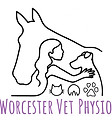
Mobile Veterinary Physiotherapy and Class 4 LASER Therapy in Worcestershire
Equine Assessment and Treatment
Assessment
Please expect a timeframe of around 2 hours for your horse’s initial assessment. I start by looking at the horse statically, this involves looking at his conformation and muscle balance to identify potential issues. I then ask to look at the horse dynamically (while moving); if appropriate, I will ask to see him walking, trotting, turning in circles, and backing up (all in-hand). Lunging and ridden assessments may sometimes be appropriate, as well as neurological testing. When the horse is moving, I am looking at how he carries himself and the way his legs move, as well as identifying any lameness and potential issues. After this, I will assess the horse’s different tissue states by palpation, as well as identifying any pain or muscular spasm in the musculoskeletal system. The assessment finishes by testing his joint ranges of motion. I use all this information gathered to tailor his treatment to his specific problems and areas that could be improved.
For follow-up appointments please expect a timeframe of 1½ hours depending on the individual. In follow-up appointments I will do a similar but briefer assessment to identify changes and improvements following the initial treatment.
Treatment
The following treatment then depends entirely on the individual. Treatments in the session may include massage, myofascial release, stretching, dynamic mobilisations, H-Wave therapy, heat therapy, and kinesiology taping, acupressure, and LASER therapy. I will then put together a remedial exercise program specifically for your horse, considering your goals, the main areas for improvement, and your home facilities and equipment available. These exercises are for you to carry out with your horse in-between appointments to maximise the benefits and get more effective results. The regularity of appointments will again depend entirely on the individual and your budget. I will also stay in communication with your veterinarian and other paraprofessionals as appropriate, for example your farrier or saddle fitter.
Conditions treated
-
Muscular pain and injury
-
Arthritis and degenerative joint conditions
-
Sacroiliac disease
-
Conservative management of conditions such as kissing spines
-
Neurological conditions
-
Tendon and ligament conditions
-
Acute and chronic pain and inflammation
-
Gait and movement abnormalities
-
Pre- and post-operative rehabilitation
-
Post-injury
-
Performance enhancement and injury prevention in competition horses
-
Behavioural problems relating to musculoskeletal pain


